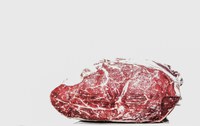Prairie Fare: Can you name the three ways to thaw food safely?
(Click an image below to view a high-resolution image that can be downloaded)
I should have worn tall boots, I thought to myself. Actually, I do not have tall enough boots. We had a two-foot snowfall with a brisk wind.
I was trudging through some snow banks on my way to my office during what was, by all predictions, the last blizzard of the season. When you live in the Midwest, anything can happen.
I was thinking about warmer days without snow. After a winter with a lot of snow, we await the spring thaw. We do not want the snow to thaw so quickly that flooding is out of control.
Slow and steady thawing was on my mind when I reached my desk. I removed my snow-filled shoes. I should have brought dry socks.
As I thawed, I opened my email and saw a question about thawing food.
The question read: “I left a frozen packet of pheasant out to thaw last night on my kitchen counter but neglected to refrigerate it before I went to bed. The thawed bag was still cold to the touch. Would the meat be safe to prepare?”
This was the person’s last package of pheasant. How would you respond and why?
Unfortunately, I had to tell the person it was not safe to eat food thawed on the counter, especially if the time was beyond two hours. I feel bad about being the bearer of bad news. I provided three safe thawing methods for future reference.
Even if the food feels cool or cold to the touch after it has thawed at room temperature, the food is not considered safe. The loss of the food would be less costly than the personal, and potentially medical, cost of foodborne illness.
How about just cooking the food longer? What’s the risk?
Unfortunately, when we thaw food at room temperature, the outer portion of the food spends too much time in the temperature danger zone of 40 to 140 degrees Fahrenheit. In this temperature range, we can expect bacterial growth and potentially, toxin production.
With warmer temperatures, bacterial growth goes faster. On average, bacteria double in number every 20 minutes.
Some types of bacteria produce heat-stable toxins (poisons).
For example, Staphylococcus aureus can be present on hands or in our nostrils. If we were to pack food for the refrigerator or freezer with our hands, the organism remains alive during cold storage, even though its growth slows or stops. It can produce a heat-stable toxin that can sicken us with cramps, nausea and vomiting within 30 minutes.
Bacillus cereus is another example of a toxin-producing bacteria especially associated with meat products, soups, sauces, vegetables and milk. The toxin can withstand cooking. The toxin forms when food has not been maintained at a safe temperature during any phase of food preparation.
Two syndromes are linked to the Bacillus cereus toxin: emetic (vomiting) or diarrheal syndrome. The symptoms start in as little as 30 minutes of consuming the food.
That doesn’t sound pleasant, does it?
Many other types of bacteria produce toxins. Therefore, we do not recommend thawing food on the counter, in the sink, in a garage, outdoors on a deck or in other creative locations.
What are the safe methods to thaw food, especially meat, poultry and fish? Refrigerator thawing is the slow and steady type of thawing. You need to plan ahead and allow a day or more depending on what you are thawing. You can re-freeze food thawed in the refrigerator, especially if it still has ice crystals.
You can place meat in a leak-proof plastic bag and submerge it in cool water (about 70 degrees Fahrenheit), changing the water every 30 minutes. If the food thaws and you change your dinner plans, you should cook the meat thoroughly right away.
Microwave-thawing is the third safe method. Microwave-thawed foods should be cooked immediately in the oven or grill, or cook it to doneness in the microwave oven.
Sometimes, you can cook meat from the frozen state but allow about one and a half times the usual cooking time, or follow the directions in a multifunction cooker. The meat may become dry with the prolonged cooking. Covering it and adding extra moisture helps. See the “Food Safety” section at www.ag.ndsu.edu/food for more information.
This recipe is easy and nutritious with the fiber- and vitamin-rich potatoes combined with chicken. Be sure to thaw the chicken using one of the recommended methods.
Barbecue Chicken Stuffed Sweet Potatoes
4 medium sweet potatoes
½ pound chicken breast, cooked
¼ cup barbecue sauce
½ cup cheddar cheese, shredded
¼ cup red onion, diced
¼ cup fresh cilantro, chopped
Cook the sweet potatoes in an oven at 400 F about 50 minutes or in a microwave oven about 10 minutes on high. Cook the chicken in an oven or on the grill to 165 F, then shred and add barbecue sauce. Top each potatoes with one-fourth of each recipe ingredient.
Makes four servings. Each serving has 270 calories, 6 grams (g) fat, 18 g protein, 34 g carbohydrate, 4 g fiber and 360 milligrams sodium.
Julie Garden-Robinson, Ph.D., R.D., L.R.D., is a North Dakota State University Extension food and nutrition specialist and professor in the Department of Health, Nutrition and Exercise Sciences. Follow her on Twitter @jgardenrobinson)
NDSU Agriculture Communication – April 13, 2023
Source: Julie Garden-Robinson, 701-231-7187, julie.garden-robinson@ndsu.edu
Editor: Elizabeth Cronin, 701-231-7881, elizabeth.cronin@ndsu.edu




